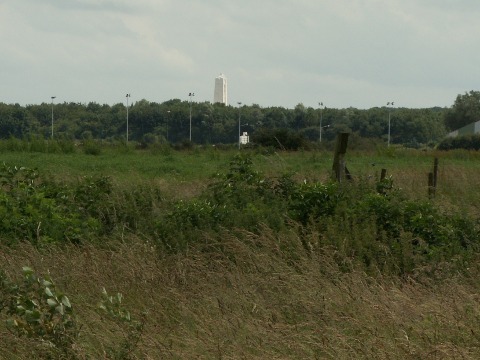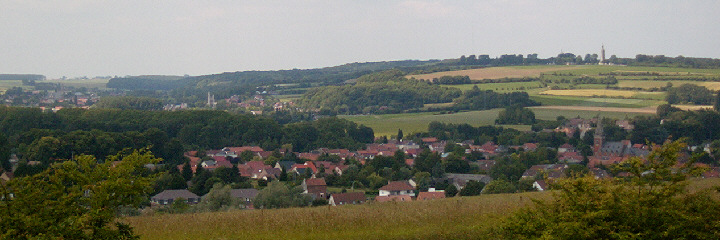Hill 119
The Pimple
Reaching this area takes a little bit of effort as it is not on the main tourist route and is outside of the Canadian Memorial Park.
From Souchez, follow the signs along the back of the houses towards Givenchy-en-Gohelle CWGC Cemetery.
As you leave the village you will turn left towards the hillside and the decent road will stop at a T junction. Take the right hand fork and this will climb a little further before ducking down under the autoroute.
After the tunnel there is a crossroads. Straight on takes you to the cemetery and the area of the Crosbie Craters whilst turning left brings you out onto the hillside.
There are some spectacular views to be had here over the area fought over by the French in 1915.

The Canadian Monument from Hill 119
Côte 119, Hill 119
Immediately overlooking the village of Souchez and the ridge of Notre Dame de Lorette, Côte 119 was a thorn in the side of the French 10th Army's efforts throughout 1915.
The hill was in French hands for short periods in May 1915 when the 77th Division managed to reach the hill and again in June 1915 when the Moroccan Division managed to fight their way through.
On each occasion though the weight of German reinforcements and artillery support forced them off.
The 3rd Battle of Artois on 25th September 1915 brought the French onto the western slopes of the hill where they would remain until pushed back off again by the Germans on 21 February 1916.
 Artois 1915
Artois 1915
This attack by the Germans coincided with the launch of their great offensive at Verdun and was intended to throw the French into confusion as to where the real threat lay.
Ultimately the French were needed at Verdun and the British arrived in the sector having taken over more of the front line.

Looking out across Souchez towards Ablain St Nazaire and Notre Dame de Lorette
The British Arrive
The British now found themselves not only under the watchful eyes of the Germans along the entire length of the ridge, but without a proper front line system immediately in front of Souchez.
The Official History quotes:
The continuous trench shown on the map does not exist. The whole ground is a quagmire, practically impossible for attack at present...
Mining operations by the Germans on Hill 119 were as ever present as that along Vimy Ridge, and there were a number of significant craters on the hill.
The reason that they are not so apparent as those within the Park is that this area has been returned to the farmers and has been tilled over. If you go up to the cemetery however on your way back to Souchez, walk up along the track and look into the wooded area (Private hunting land - stay out). The remains of the war can still be seen quite easily.
Experiences elsewhere along the British lines had shown the need for properly trained and equipped Tunnelling Companies and this would be one of the areas in which they would be most active.
 The formation of the Tunnellers
The formation of the Tunnellers
The Tunnelling Companies did not just carry out mining warfare they also provided the means to create the kilometres of passageways that would eventually bear fruit on 9th April 1917 as the Canadians took Vimy Ridge by storm.
12 May 1917
The 4th Canadian Division
The main Canadian assault on Vimy Ridge was launched on the morning of 9th April. It was 4th Division's task to take out Hill 145 where the Canadian Monument stands today and then move on to Hill 119 three days later.
Hill 145 proved to be trickier than other sections of the ridge as the German positions were of a greater depth. It would take the 4th Division until the afternoon of the 10th to clear the hill of its German defenders.
Their first task accomplished the Division switched its attentions to its left flank. On the 12th the Canadian 10th Brigade went into the attack at 0500 hours after a short preliminary bombardment of shell and gas against the German lines and reserve areas in the village of Givenchy-en-Gohelle.
Unlike the French attack on the hill two years earlier on a sunny May morning, this assault was carried out in the teeth of a freezing, snow swept wind.
Resistance was stubborn but swiftly dealt with and before dawn the hill was Canadian.
The three battalions concerned in the attack were the:
44th (Manitoba) Bn
46th (South Saskatchewan) Bn
50th (Alberta) Bn
Both the 44th and 46th Battalions erected memorials to their men, but these have since been removed. In the case of the Manitoba memorial it was taken back to Winnipeg in 1926 and now sits in Vimy Ridge Park.
Private Henry Norwest MM and Bar
One man in particular made his mark here and that was a sniper from the 50th Bn called Henry Norwest a French-Cree aboriginal (Métis). Born in Fort Saskatchewan on 1st May 1884 he worked as a ranch hand and rodeo performer before joining the battalion in 1915.
His natural ability to remain motionless for hours and his superb camouflaging techniques made him ideally suited to the task of Battalion Sniper. He, himself, felt that with such abilities it was his duty to undertake such a dangerous role, often well out in front of his own trenches.
At the Pimple he dispatched so many German snipers that he won a Military Medal for his efforts.
...showing great bravery, skill and initiative in sniping the enemy after the capture of the Pimple. By his activity he saved a great number of our men's lives.
In 1918 he would earn a bar to his medal - again for his abilities as a marksman and making himself the Battalion record holder at 115 accredited kills.
Sadly on 18th August 1918 whilst trying to take out a group of German snipers he himself was hit and killed.
 Calling Home the Métis Spirits
Calling Home the Métis Spirits
 Warvillers Churchyard Extension
Warvillers Churchyard Extension
He is buried in the Warvillers Churchyard Extension
As you come back down the hillside towards Souchez, the road immediately to the left when you reach the houses takes you down Zouave Valley and to the CWGC Cemetery of that name.
 Zouave Valley Cemetery
Zouave Valley Cemetery
 The Crosbie Craters
The Crosbie Craters



